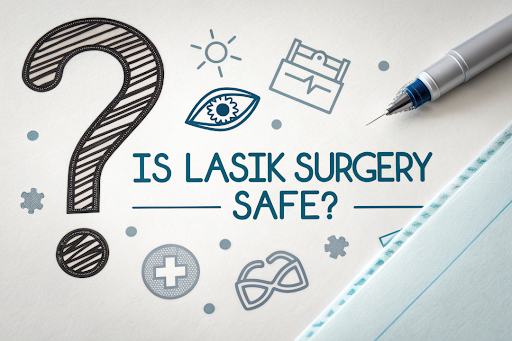
Laser-Assisted in Situ Keratomileusis (LASIK) is a popular laser eye surgery used to correct vision issues such as myopia, hyperopia, and astigmatism. It is classified as an elective surgical procedure, often chosen by patients looking to reduce or eliminate their dependence on glasses or contact lenses. This refractive eye surgery reshapes the cornea to allow light to be properly focused onto the retina, improving visual acuity.
Is LASIK Surgery Safe?
Yes, LASIK eye surgery is safe for the majority of candidates when performed by an experienced and board-certified LASIK surgeon in a certified medical center. According to PubMed and PMC, LASIK boasts a success rate of over 96%, with most patients achieving 20/20 vision or better.
- Important: As with any surgical procedure, there are risks and potential complications involved, which we will explore below.
LASIK Surgery Risks and Side Effects
While generally considered a safe surgery, patients should be informed of possible side effects and LASIK complications, including:
Common LASIK Side Effects
- Dry Eyes After LASIK - Temporary decrease in tear production; usually resolves within weeks.
- Night Vision Issues Post-LASIK - Some patients report glare, halos, or double vision, especially in low light.
- Corneal Flap Complications - Issues with the healing of the corneal flap created during the procedure.
- Regression - Partial return of refractive error over time.
Rare Complications
- Eye infections or delayed healing
- Persistent visual disturbances
- Undercorrections or overcorrections
Chart: LASIK Risk Overview
| Complication | Frequency | Resolution Timeline |
|---|---|---|
| Dry Eyes | ~30% | Usually within 6 months |
| Night Vision Issues | ~18% | Often resolves in 3-6 months |
| Corneal Flap Issues | <1% | Treated with follow-up care |
| Infection or Inflammation | <0.5% | Antibiotic treatment |
| Regression (need for enhancement) | ~5-10% | LASIK enhancement possible |
LASIK vs. LASEK Safety
LASEK (Laser-Assisted Sub-Epithelial Keratectomy) is a similar refractive laser eye procedure but involves a different technique.
| Feature | LASIK | LASEK |
|---|---|---|
| Recovery Time | Shorter (1-2 days) | Longer (4-7 days) |
| Pain Level | Minimal | Mild to moderate |
| Suitability | Thicker corneas | Thin or irregular corneas |
| Safety Profile | Very High | High |
Who Is an Ideal Candidate for LASIK?
Not everyone qualifies for LASIK. Here are key LASIK candidacy criteria:
- Age 18+ with stable prescription for at least one year
- Good general eye health
- No history of eye injuries or corneal diseases
- Not pregnant or breastfeeding
- Realistic expectations
Consult an experienced ophthalmologist or refractive surgeon to confirm your eligibility.
Patient Testimonials and Success Stories
Thousands of patients share positive LASIK eye surgery reviews online. According to mohaneyeinstitute.com and tlcvision.com, many patients report improved quality of life and freedom from glasses.
"I had my LASIK Eye Surgery in Lucknow, and I can't believe how quick and painless it was! Within a day, I was back to work with crystal-clear vision." - LASIK recipient from Lucknow
LASIK Surgery in India: A Cost-Effective Option
LASIK Eye Cost in India is among the lowest globally, without compromising quality. Prices typically range from INR 25,000 to INR 80,000 per eye, depending on the technology used (e.g., blade-free LASIK or topography-guided LASIK).
Why Choose India?
- Skilled eye surgeons and modern clinical ophthalmology centers
- Affordable laser treatment options
- High safety standards and hygiene protocols
Final Verdict: Is LASIK Eye Surgery Safe?
In most cases, LASIK is a safe surgical procedure with a high satisfaction rate and minimal complications. It remains one of the most trusted refractive surgery options worldwide. Choosing the right doctor, understanding the risks, and following post-op care are crucial for a successful procedure.